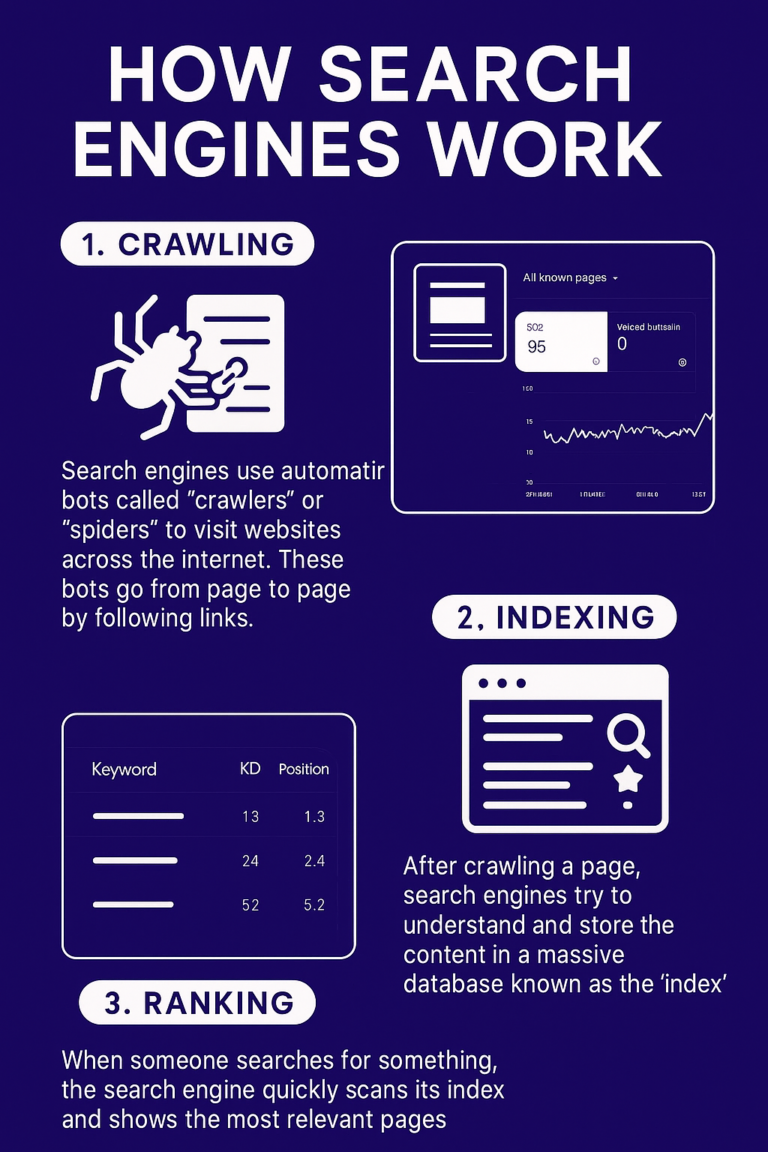If you’re just starting in the world of digital marketing, you’ve likely heard about SEO or Search Engine Optimization. But what exactly is SEO, and why is it important for your website? Don’t worry, this guide will break it down in simple terms to help you understand the basics and get started on the right path
Table of Contents
ToggleWhat is SEO?
SEO stands for Search Engine Optimization. It’s the process of making your website appear higher in search engine results—especially on Google.Imagine you’ve started a business or a blog. People are searching for what you offer, but if your website isn’t optimized, they’ll never find you. SEO marketing helps your site get seen without paying for ads.Think of SEO like putting up a big, glowing signboard in the middle of the internet highway.
Why SEO Matters in 2025
People rarely scroll past Google’s first page, making SEO marketing essential. SEO delivers free organic traffic, builds trust, enhances user experience, works continuously, and boosts conversions. In fact, 53% of all website traffic comes from search—a powerful proof of why investing in SEO pays off.
The 3 Pillars of SEO
We’ll cover everything from basics to advanced strategies, inspired by Pouya Eti’s guides:
Technical SEO
Technical SEO focuses on how well your website is built and whether it’s accessible to both users and search engines. For beginners, this might sound intimidating, but don’t worry—it’s about making sure your site loads fast, is mobile-friendly, and has a secure HTTPS connection.
A fast-loading website not only improves user experience but also boosts rankings. You can use tools like Google PageSpeed Insights or GTmetrix to analyze and improve your loading time. Mobile responsiveness is equally important, as over half of all web traffic comes from smartphones.
You should also create and submit your XML sitemap through Google Search Console, which helps Google index your site pages effectively. Fix any crawl errors or broken pages you find during the process. These are typically the first tasks an experienced SEO specialist will tackle during a technical audit.
On-Page SEO
on-page SEO focuses on everything that lives within your website’s pages—from headlines and images to the way your content is written and structured. One of the first steps in on-page optimization is keyword research. Using tools like Google Keyword Planner or Surfer SEO, you can discover terms that people are actively searching for, such as “SEO services” or “what is local SEO”. These become your target keywords, and they should be used naturally throughout your page, especially in the title, headings, and first paragraph.
Each page should have a clear and focused title that includes your main keyword as early as possible. URLs should be short, clean, and descriptive. The meta description, which shows up in search results under your page title, should also include your keywords and explain what the user will find on your page—in under 160 characters. Headings like H1 and H2 tags should help organize your content in a logical way, making it easy to read and scan. Adding internal links to your own related articles keeps users engaged and helps search engines understand the structure of your site. Don’t forget to optimize your images as well, using relevant file names and alt text that includes your keywords.
For example, in this SEO guide, you’ll learn how website SEO can improve your ranking by making your site easier to understand and more relevant to search engines. If you’re using WordPress, plugins like Rank Math and Yoast SEO can guide you through these on-page tasks with checklists and scoring systems. These tools are especially helpful for beginners and are widely used by both individuals and professionals working in SEO marketing.
Off-Page SEO
Off-page SEO refers to everything you do outside of your own website to improve your rankings. This is mainly about building your site’s authority and credibility through backlinks and external mentions. When other reputable websites link to your content, it sends a signal to search engines that your site is trustworthy and valuable. This is one of the most powerful ways to improve your visibility online.
To get started with off-page SEO, you can begin by reaching out to blogs, industry websites, or local directories and sharing helpful content they might want to link to. Building relationships in your industry can also open doors to guest posting, interviews, or co-created content that earns you high-quality links. It’s important to use a mix of anchor texts when getting links, including your brand name, exact keyword phrases, and natural phrases like “click here” or “read more”. Just like internal linking helps guide users within your own site, these backlinks help guide external traffic toward your site and show Google that others trust your content.
So what is off page SEO exactly? It includes link building, brand mentions, social signals, forum participation, and even influencer collaborations. These efforts all contribute to building your online reputation. A strong off-page SEO strategy not only improves your Google ranking but also opens the door to more traffic, engagement, and business growth. If you’re unsure where to start, hiring an SEO agency or SEO company with link-building experience can fast-track your results while avoiding spammy tactics.
What is Local SEO?
If you’re a local business or service provider, Local SEO is your secret weapon to attract nearby customers. So, what is local SEO exactly? It’s the process of optimizing your online presence so that your business shows up when people search for services “near me” or within a specific location—like “SEO agency in Pune” or “SEO services near me.” This is especially useful for physical businesses, freelancers, or agencies looking to grow in a specific region.
The first and most important step is to create and fully optimize your Google Business Profile. This includes adding accurate NAP information (Name, Address, Phone Number), business hours, service areas, and a detailed business description that includes your primary keywords. Uploading real images of your office or team and keeping everything up to date signals trust and professionalism to both users and search engines.
Customer reviews also play a huge role in local SEO. Encouraging happy clients to leave a review not only improves your chances of ranking in the local map pack (the box that shows businesses with maps) but also builds trust with potential leads. Google values fresh, relevant reviews as a sign that your business is active and reputable.
Using local keywords naturally throughout your website, such as city names or neighborhoods you serve, also helps search engines connect your services with nearby searches. For example, if you’re a local SEO company or freelancer offering SEO marketing, including phrases like “affordable SEO services in Mumbai” or “trusted SEO specialist in Delhi” can improve your chances of being found.
In short, Local SEO makes it easier for people in your area to discover, trust, and contact you—often leading to quicker conversions and long-term clients.
How do search engines actually work?

To understand SEO deeply, it’s important to first understand how search engines like Google work behind the scenes. Every time you type a query into the search bar, there’s a complex process that takes place in milliseconds. This process has three main steps: crawling, indexing, and ranking.
1.crawling : Search engines use automated bots called “crawlers” or “spiders” to visit websites across the internet. These bots go from page to page by following links, just like you might click through a website. Their job is to discover new content, updates, and any changes to your website. That’s why proper internal linking and clean navigation are a big part of effective website SEO.
2. indexing : After crawling a page, search engines try to understand and store the content in a massive database known as the “index.” If your site isn’t indexed, it won’t appear in search results at all. This is why SEO specialists often use tools like Google Search Console to check if a site is being indexed properly. A well-structured page with relevant headings, keywords, and optimized images is more likely to be indexed correctly. You can include a screenshot here of the Google Search Console “Coverage” or “Pages” section to show indexing status.
3. ranking : When someone searches for something, the search engine quickly scans its index and shows the most relevant pages based on hundreds of ranking factors. These include content quality, keyword usage, mobile-friendliness, page speed, backlinks, and user engagement. So, if you follow an expert SEO guide and apply best practices consistently—whether through content, links, or technical improvements—your website has a higher chance of appearing on the first page. You may add a screenshot here showing a page’s average position or keyword ranking using tools like Ahrefs or Ubersuggest.
In short, search engines don’t just look for websites—they look for well-optimized, useful, and trustworthy content. That’s the real goal of smart SEO marketing.
Paid Search vs. Organic Search: Which One’s Right for You?
When it comes to showing up on Google, there are two main paths: paid search and organic search. Both are part of a broader digital strategy, but they work very differently.
Paid search, often known as PPC (pay-per-click), involves running ads through platforms like Google Ads. Businesses pay every time someone clicks on their link. These ads usually appear right at the top of search results, which gives instant visibility. It’s ideal for time-sensitive promotions, product launches, or new businesses that want to drive quick traffic. However, once the ad budget runs out, the traffic stops. It’s a short-term investment that gives fast results—but at an ongoing cost. That’s why many companies hire an SEO agency or marketing expert to manage these campaigns carefully.
On the other hand, organic search is powered by SEO marketing. It doesn’t cost anything per click but does require effort in optimizing your website for long-term success. Through content creation, keyword optimization, and technical improvements (what we call website SEO), you can improve your rankings over time. The process is slower than paid search, but the traffic you gain is more sustainable. Users tend to trust organic results more than ads, which leads to higher click-through rates and stronger brand credibility.
In short, paid search is perfect when you need fast visibility, while organic search through SEO offers lasting growth. Many businesses use a mix of both, but for long-term success, investing in strong SEO services ensures your business stays visible, trustworthy, and competitive—even without an ad budget.
organic result

paid result

How Does Google Rank Search Results
When you search something on Google, the results you see aren’t random—they’re ranked based on a complex system of over 200 factors. These include keyword relevance, page quality, site speed, backlinks, mobile-friendliness, and user behavior. One of the most important parts of this system is RankBrain—Google’s artificial intelligence algorithm.
So what exactly is RankBrain? It’s a machine learning system that helps Google understand the intent behind search queries. Instead of just matching exact words, RankBrain tries to figure out what you mean and what kind of content would best answer your question. This means that even if your page doesn’t have the exact keyword, Google might still rank it high if the content truly solves the user’s problem.
To optimize for RankBrain, focus less on keyword stuffing and more on creating helpful, easy-to-read content that answers user questions clearly. Use natural language, include related keywords, and organize your content with proper headings (H1, H2, H3) that make sense to both readers and search engines. An SEO specialist would also recommend improving website SEO factors like mobile responsiveness, loading speed, and internal linking—because RankBrain also looks at how users behave on your site. Do they stay and explore? Or do they bounce back to Google?
In short, if your goal is to rank well on Google in 2025 and beyond, your SEO guide should prioritize user experience and value, not just keywords. That’s how you align with RankBrain—and build strong, lasting visibility through SEO marketing.
How to Become an SEO Specialist
Becoming an SEO specialist doesn’t require a fancy degree or technical background—it starts with curiosity and consistency. If you’re someone who enjoys solving problems, analyzing patterns, and helping websites grow, then SEO could be a great fit for you. Begin with the basics by reading a reliable SEO guide (like this one!), watching YouTube tutorials, or enrolling in a free course from platforms like Google or HubSpot.
As you learn, practice is key. Apply what you’ve learned by optimizing your own blog or helping a friend’s website. Get hands-on with tools like Google Search Console, Ubersuggest, or Rank Math to understand how website SEO really works. Learn the difference between on-page, off-page, and technical SEO—because an effective SEO marketing strategy balances all three. Over time, you’ll build confidence in analyzing keywords, improving content, fixing site issues, and even offering your own SEO services.
Once you’re comfortable, consider offering freelance SEO help, applying to an SEO agency, or joining a digital marketing team. Keep learning through blogs, podcasts, and staying updated with Google’s algorithm changes. The best SEO specialists never stop learning—and that’s what makes this field both exciting and future-proof.
Google’s AI Overview (SGE): The Future of SEO is Here
Artificial Intelligence is no longer just a buzzword—it’s actively transforming how SEO works. From content creation to keyword research, AI is now a powerful ally for SEO specialists, marketers, and business owners.
In 2024 and beyond, Google continues evolving with AI-powered features like Search Generative Experience (SGE). This feature uses generative AI to summarize information from multiple sources and present instant, conversational answers right at the top of the search page—before the organic results.
What Is Google’s AI Overview (SGE)?
SGE, also known as “AI Overviews,” offers users summarized answers to complex queries, reducing the need to click on multiple links. It’s part of Google’s shift toward a more intuitive, conversational search experience.
Instead of typing keywords like “best SEO tools”, users now ask questions like “What are the top free SEO tools for beginners?” or use voice search. Google’s AI responds by pulling trusted content and presenting it in a human-like tone.
What This Means for SEO in 2025
-
User behavior is changing – people expect quick, helpful, complete answers.
-
Traditional SEO isn’t enough – your strategy needs to focus on topical depth, natural language, and clear structure.
-
Ranking for AI Overviews is like winning the top snippet—only trustworthy, well-structured, and relevant content is featured.
How to Optimize for AI-Powered Search:
-
Write conversational, question-driven content.
-
Use FAQ sections, bullet points, and concise summaries.
-
Structure your content with proper H2s, H3s, and schema.
-
Focus on topical authority—cover related subtopics deeply.
-
Prioritize user-first helpfulness over robotic keyword stuffing.
-
Tip: Think of yourself as a source Google’s AI would trust to summarize. Make your blog the best answer, not just an answer.
Human + AI = Winning SEO Strategy
Google’s algorithms like RankBrain and BERT are also AI-based—they help Google understand natural language and user intent. That’s why your content needs to feel authentic, helpful, and human.
The future of SEO is not just technical—it’s intentional, conversational, and intelligent.💡 Curious how to train Google’s AI to send you customers—not just traffic?👉 Dive into our complete guide on Google AI Mode & GEO strategy to start optimizing beyond the traditional SEO playbook.




